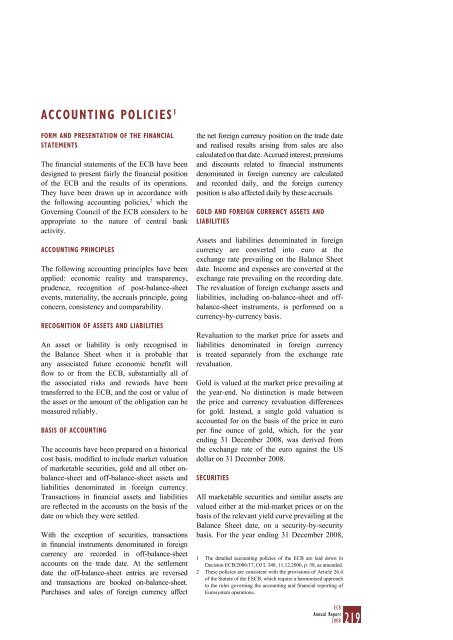ANNUAL REPORT 2008 - Polymer Bank Notes of the World
ANNUAL REPORT 2008 - Polymer Bank Notes of the World
ANNUAL REPORT 2008 - Polymer Bank Notes of the World
You also want an ePaper? Increase the reach of your titles
YUMPU automatically turns print PDFs into web optimized ePapers that Google loves.
ACCOUNTING POLICIES 1FORM AND PRESENTATION OF THE FINANCIALSTATEMENTSThe financial statements <strong>of</strong> <strong>the</strong> ECB have beendesigned to present fairly <strong>the</strong> financial position<strong>of</strong> <strong>the</strong> ECB and <strong>the</strong> results <strong>of</strong> its operations.They have been drawn up in accordance with<strong>the</strong> following accounting policies, 2 which <strong>the</strong>Governing Council <strong>of</strong> <strong>the</strong> ECB considers to beappropriate to <strong>the</strong> nature <strong>of</strong> central bankactivity.ACCOUNTING PRINCIPLESThe following accounting principles have beenapplied: economic reality and transparency,prudence, recognition <strong>of</strong> post-balance-sheetevents, materiality, <strong>the</strong> accruals principle, goingconcern, consistency and comparability.RECOGNITION OF ASSETS AND LIABILITIESAn asset or liability is only recognised in<strong>the</strong> Balance Sheet when it is probable thatany associated future economic benefit willflow to or from <strong>the</strong> ECB, substantially all <strong>of</strong><strong>the</strong> associated risks and rewards have beentransferred to <strong>the</strong> ECB, and <strong>the</strong> cost or value <strong>of</strong><strong>the</strong> asset or <strong>the</strong> amount <strong>of</strong> <strong>the</strong> obligation can bemeasured reliably.BASIS OF ACCOUNTINGThe accounts have been prepared on a historicalcost basis, modified to include market valuation<strong>of</strong> marketable securities, gold and all o<strong>the</strong>r onbalance-sheetand <strong>of</strong>f-balance-sheet assets andliabilities denominated in foreign currency.Transactions in financial assets and liabilitiesare reflected in <strong>the</strong> accounts on <strong>the</strong> basis <strong>of</strong> <strong>the</strong>date on which <strong>the</strong>y were settled.With <strong>the</strong> exception <strong>of</strong> securities, transactionsin financial instruments denominated in foreigncurrency are recorded in <strong>of</strong>f-balance-sheetaccounts on <strong>the</strong> trade date. At <strong>the</strong> settlementdate <strong>the</strong> <strong>of</strong>f-balance-sheet entries are reversedand transactions are booked on-balance-sheet.Purchases and sales <strong>of</strong> foreign currency affect<strong>the</strong> net foreign currency position on <strong>the</strong> trade dateand realised results arising from sales are alsocalculated on that date. Accrued interest, premiumsand discounts related to financial instrumentsdenominated in foreign currency are calculatedand recorded daily, and <strong>the</strong> foreign currencyposition is also affected daily by <strong>the</strong>se accruals.GOLD AND FOREIGN CURRENCY ASSETS ANDLIABILITIESAssets and liabilities denominated in foreigncurrency are converted into euro at <strong>the</strong>exchange rate prevailing on <strong>the</strong> Balance Sheetdate. Income and expenses are converted at <strong>the</strong>exchange rate prevailing on <strong>the</strong> recording date.The revaluation <strong>of</strong> foreign exchange assets andliabilities, including on-balance-sheet and <strong>of</strong>fbalance-sheetinstruments, is performed on acurrency-by-currency basis.Revaluation to <strong>the</strong> market price for assets andliabilities denominated in foreign currencyis treated separately from <strong>the</strong> exchange raterevaluation.Gold is valued at <strong>the</strong> market price prevailing at<strong>the</strong> year-end. No distinction is made between<strong>the</strong> price and currency revaluation differencesfor gold. Instead, a single gold valuation isaccounted for on <strong>the</strong> basis <strong>of</strong> <strong>the</strong> price in europer fine ounce <strong>of</strong> gold, which, for <strong>the</strong> yearending 31 December <strong>2008</strong>, was derived from<strong>the</strong> exchange rate <strong>of</strong> <strong>the</strong> euro against <strong>the</strong> USdollar on 31 December <strong>2008</strong>.SECURITIESAll marketable securities and similar assets arevalued ei<strong>the</strong>r at <strong>the</strong> mid-market prices or on <strong>the</strong>basis <strong>of</strong> <strong>the</strong> relevant yield curve prevailing at <strong>the</strong>Balance Sheet date, on a security-by-securitybasis. For <strong>the</strong> year ending 31 December <strong>2008</strong>,1 The detailed accounting policies <strong>of</strong> <strong>the</strong> ECB are laid down inDecision ECB/2006/17, OJ L 348, 11.12.2006, p. 38, as amended.2 These policies are consistent with <strong>the</strong> provisions <strong>of</strong> Article 26.4<strong>of</strong> <strong>the</strong> Statute <strong>of</strong> <strong>the</strong> ESCB, which require a harmonised approachto <strong>the</strong> rules governing <strong>the</strong> accounting and financial reporting <strong>of</strong>Eurosystem operations.ECBAnnual Report<strong>2008</strong>219




![KNOW YOUR NEW GIBRALTAR BANKNOTES - [Home] bThe/b](https://img.yumpu.com/50890985/1/184x260/know-your-new-gibraltar-banknotes-home-bthe-b.jpg?quality=85)
![PAPUA NEW GUINEA - [Home] - Polymer Bank Notes of the World](https://img.yumpu.com/49758743/1/190x143/papua-new-guinea-home-polymer-bank-notes-of-the-world.jpg?quality=85)










